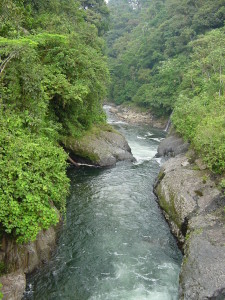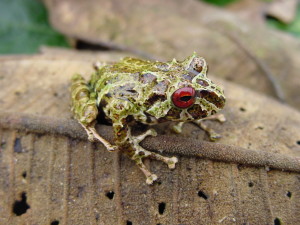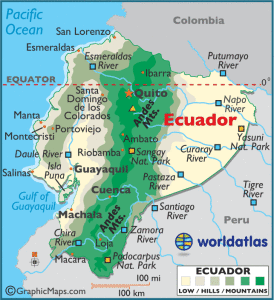You could think of Ecuador as the southern branch of the CSU Department of Biology. Five faculty members have established research sites in that exquisitely beautiful country to study ecology and evolutionary biology. (For more on their research, scroll to the end of this article and click on the links to their labs.)
When all five professors are in the same room talking about their experiences in Ecuador, the air crackles with energy. By the end of the conversation, ideas are flying on new collaborations and developing new courses to enhance the relationship between Ecuador and CSU. The research is exciting and the collaborations generate even more potential to push the edge of scholarship in this exciting ecosystem.
As would be expected, Ecuador is culturally very different from the US and working with local collaborators is a key factor in making progress. Without an Ecuadorian scientist on the project to share knowledge of the local flora and fauna and help with the permits and bureaucracy, life is so much more difficult. For example, to leave the country with plant or animal samples in hand, you must have a permit from the government. On one trip, after waiting months, that permit was issued the day before Dr. Pat Bedinger was scheduled to leave. “That can be enormously frustrating,” she said.
The citizens of Ecuador are increasingly aware of the potential of their country’s environment and welcome researchers. Many local researchers are US trained and quite open to alliances. As Dr. Kim Hoke said enthusiastically, “These relationships dramatically shape our research.”
In addition to the research, sharing knowledge through teaching is an area where the partnerships shine. Through collaboration with the local university in the capital city, Quito, Dr. Hoke teaches classes in next-generation sequencing to scientists, and neuroethology to undergraduate students. Here at CSU, Dr. Chris Funk advises Ecuadorian Ph.D. student Mónica Páez and teaches BZ482, Ecology, Evolution and Conservation of Ecuadorian Biodiversity. Part of that classwork brings his CSU students to Ecuador for three weeks in the summer for incomparable hands-on learning.
In a different collaborative effort, Dr. Bedinger is currently in conversation with a faculty member in Loja seeking to establish a seed bank on their campus to preserve genes of wild and cultivated species. Repositories of genetic material are not new to CSU where the USDA maintains a seed bank on the Fort Collins campus. http://www.ars.usda.gov/main/site_main.htm?modecode=30-12-05-00
Current plans will have an Ecuadorian scientist come to CSU and the University of California – Davis to receive specific training in how to set up and maintain a seed bank.
Ecuador, a relatively small country about the size of Colorado, is especially attractive because of its astonishing biodiversity. “Megadiversity,” actually. For example, in all of the US and Canada, there are about 800 species of birds; Ecuador has about 1700. Working in Ecuador is also attractive because there are roads to get to the remote areas. Researchers can travel from one research site to another without undue hardship.
Additionally, this country has a huge variety of habitats. There are very high mountains (20,000+ foot elevation), active volcanoes, the Amazon Basin, rainforests, coastal regions, and plenty of rivers and lakes. Some areas are really dry, for example along the southwestern Ecuadorian coast, and places that are really wet, like the southern tip of the Chocó rainforest, in the northwestern corner of Ecuador.
Altitudinally, because of its proximity to the equator, the climate is very stable at any given elevational zone. It’s always cold at the top of mountains and always warm in the lowlands. One researcher, working for a period of time at 10,000 feet found that a coat and gloves were not enough. She needed a heater to keep her hands supple. This stability in bands of climate creates a lot of biodiversity, but conversely makes organisms more vulnerable to climate change, as they are adapted to narrow ranges of temperatures.
 Collaboration will continue even as Ecuador takes economic advantage of their environment. Development of the land is increasing, including an oil and gas pipeline that transverses the Andes. Capturing the energy of the many rivers to generate electricity means that dams can go up overnight and change the landscape suddenly and irreparably.
Collaboration will continue even as Ecuador takes economic advantage of their environment. Development of the land is increasing, including an oil and gas pipeline that transverses the Andes. Capturing the energy of the many rivers to generate electricity means that dams can go up overnight and change the landscape suddenly and irreparably.
Rapid change and unparalleled biodiversity in Ecuador has potential for exciting research, and top scientists in that country are eager to continue working with CSU. Perhaps one day, working on the south side of campus will mean something different entirely!
Research in Ecuador
Dr. Pat Bedinger: http://wp.natsci.colostate.edu/bedinger/
Dr. Chris Funk: http://wp.natsci.colostate.edu/funklab/
Dr. Cameron Ghalambor: http://sites.www.biology.colostate.edu/ghalamborlab/Ghalambor_Lab/Welcome.html
Dr. Kim Hoke: http://hokelab.weebly.com/
Dr. LeRoy Poff: http://rydberg.www.biology.colostate.edu/poff/


